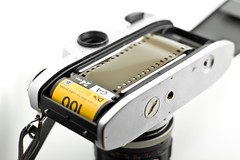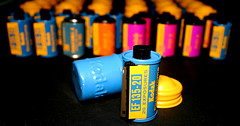Difference between revisions of "35mm film"
m |
(text contribution) |
||
| Line 1: | Line 1: | ||
''See the [[:Category: 35mm film]].'' | ''See the [[:Category: 35mm film]].'' | ||
| − | The '''35mm''' film format | + | The '''35mm''' film format was developed and produced at an experimental scale in Thomas A. Edison's laboratory in New Jersey by splitting 70mm roll film. Edison compiled his caveat for the double perforated cine film in the fall of 1889, described as a double perforated long band passing from one reel to another, driven by toothed sprocket wheels. The film was obtained from the [[Kodak|Eastman Dry Plate and film Company]] in Rochester, NY. However it took several years to become a regular [[Kodak]] product. |
| − | + | The cine film was cheap and unused short cut-off bits would certainly be available early on for use in small cameras which were easily portable in comparison the common large-format plate cameras of the time. The cine film emulsion had at first very fin grain structure and slow speed, but as the studios started filming inside faster emulsions were required on expense of the grain size, ironically making it less suitable for 35mm still cameras once they became generally available. Although the first design was patented as early as 1908, it is generally accepted that the first commercially available 35mm camera was the 1913 Tourist Multiple, for both movie and still photography, soon followed by the Simplex providing selection between full and half frame format. Oskar Barnack's built his prototype [[Leica|Ur-Leica]] in 1913 and had it patented, but [[Leitz|Ernst Leitz]] did not decided to produce it before 1924. | |
{{Flickr_image | {{Flickr_image | ||
| Line 11: | Line 11: | ||
|image_text= loading a cassette into a typical<br />35mm camera (a [[Soligor]] [[SLR]]) | |image_text= loading a cassette into a typical<br />35mm camera (a [[Soligor]] [[SLR]]) | ||
}} | }} | ||
| − | '''135 format''' | + | The standard '''135 format''' using 35mm perforated film in cassettes for the still camera has a frame size of 24×36mm - twice the cine frame size. Modern cassettes typically have enough film for 12, 24 or 36 frames. 35mm became by far the most widely used photographic film format until the event of the [[digital camera]]. |
| + | |||
| + | The cine film was at first bought in bulk and loaded into the cameras in the dark room, but [[Leitz]] introduced a film cassette which could be loaded with 1.6 meter in the darkroom and be loaded in daylight into the camera. Several photographic suppliers made such daylight cassettes for the user to load from bulk. By the early 1930s film manufacturers supplied film in disposable cassettes, and in 1936 [[Kodak]] made it an industry standard by introducing the Kodachrome film in cassette for their [[Retina]] cameras. | ||
| + | |||
| + | Bulk backs are available for some cameras, aimed at professional use, which allow the photographer to use 100-foot lengths of film at a time, minimizing the inconvenience of having to reload the camera and miss a shot. These were used by some sports photographers, but the digital revolution has largely made bulk backs obsolete. | ||
{{Flickr_image | {{Flickr_image | ||
|image_source= http://www.flickr.com/photos/cameraguy61/2514685826/in/pool-camerapedia | |image_source= http://www.flickr.com/photos/cameraguy61/2514685826/in/pool-camerapedia | ||
| Line 18: | Line 22: | ||
|image_text= 35mm cassettes | |image_text= 35mm cassettes | ||
}} | }} | ||
| − | |||
| − | |||
There were other, rival daylight-loading systems, but most of these were minority formats compared to 135. The most successful was the [[Agfa]] Karat system, which was introduced for the [[Agfa Karat|Agfa Karat cameras]] in 1936, and was produced until 1963. In 1964 Agfa introduced a 35mm cartridge system, called [[Rapid film|Rapid]], to compete with [[126 film|126 cartridges]]. The latest, and likely last rival being [[APS]] - which may have succeeded but for the rise of [[digital camera|digital]]. | There were other, rival daylight-loading systems, but most of these were minority formats compared to 135. The most successful was the [[Agfa]] Karat system, which was introduced for the [[Agfa Karat|Agfa Karat cameras]] in 1936, and was produced until 1963. In 1964 Agfa introduced a 35mm cartridge system, called [[Rapid film|Rapid]], to compete with [[126 film|126 cartridges]]. The latest, and likely last rival being [[APS]] - which may have succeeded but for the rise of [[digital camera|digital]]. | ||
Revision as of 23:53, 13 August 2009
See the Category: 35mm film.
The 35mm film format was developed and produced at an experimental scale in Thomas A. Edison's laboratory in New Jersey by splitting 70mm roll film. Edison compiled his caveat for the double perforated cine film in the fall of 1889, described as a double perforated long band passing from one reel to another, driven by toothed sprocket wheels. The film was obtained from the Eastman Dry Plate and film Company in Rochester, NY. However it took several years to become a regular Kodak product.
The cine film was cheap and unused short cut-off bits would certainly be available early on for use in small cameras which were easily portable in comparison the common large-format plate cameras of the time. The cine film emulsion had at first very fin grain structure and slow speed, but as the studios started filming inside faster emulsions were required on expense of the grain size, ironically making it less suitable for 35mm still cameras once they became generally available. Although the first design was patented as early as 1908, it is generally accepted that the first commercially available 35mm camera was the 1913 Tourist Multiple, for both movie and still photography, soon followed by the Simplex providing selection between full and half frame format. Oskar Barnack's built his prototype Ur-Leica in 1913 and had it patented, but Ernst Leitz did not decided to produce it before 1924.

|
| loading a cassette into a typical 35mm camera (a Soligor SLR) |
The standard 135 format using 35mm perforated film in cassettes for the still camera has a frame size of 24×36mm - twice the cine frame size. Modern cassettes typically have enough film for 12, 24 or 36 frames. 35mm became by far the most widely used photographic film format until the event of the digital camera.
The cine film was at first bought in bulk and loaded into the cameras in the dark room, but Leitz introduced a film cassette which could be loaded with 1.6 meter in the darkroom and be loaded in daylight into the camera. Several photographic suppliers made such daylight cassettes for the user to load from bulk. By the early 1930s film manufacturers supplied film in disposable cassettes, and in 1936 Kodak made it an industry standard by introducing the Kodachrome film in cassette for their Retina cameras.
Bulk backs are available for some cameras, aimed at professional use, which allow the photographer to use 100-foot lengths of film at a time, minimizing the inconvenience of having to reload the camera and miss a shot. These were used by some sports photographers, but the digital revolution has largely made bulk backs obsolete.

|
| 35mm cassettes |
There were other, rival daylight-loading systems, but most of these were minority formats compared to 135. The most successful was the Agfa Karat system, which was introduced for the Agfa Karat cameras in 1936, and was produced until 1963. In 1964 Agfa introduced a 35mm cartridge system, called Rapid, to compete with 126 cartridges. The latest, and likely last rival being APS - which may have succeeded but for the rise of digital.
The frugal photographer can still buy 35mm film in 100-foot lengths and spool his own cassettes. This involves putting the roll of film into a bulk loader. Reloadable cassettes are then filled with film using a crank on the loader. The film is then cut and a leader cut into the tail of the loaded cassette. All this can be done in daylight, hence the loaders are called "daylight loaders".
Trivia:
When it was first introduced in the 1930s, the 35mm format was known as "miniature format".